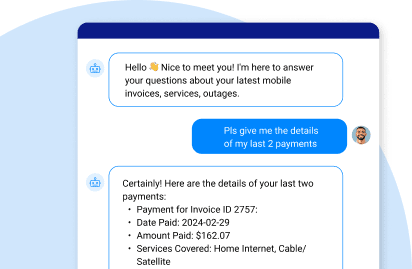Imagine users receiving fresh accurate info all the time. Retrieval-augmented generation optimizes conversational AI by injecting LLMs with enterprise data.
Conversational AI defined
Conversational AI is a branch of Generative AI (GenAI) that enables machines to simulate conversation with humans. Conversational AI leverages a powerful combination of 2 technologies: (1) Natural Language Processing (NLP), that helps the GenAI app understand the meaning behind the words, and (2) Machine Learning (ML), that continually trains and improves it. Conversational AI models are trained on massive amounts of text and speech data, which allow them to recognize human communication patterns and respond in a natural way.
Retrieval-augmented generation defined
Retrieval-Augmented Generation (RAG) tackles a key challenge in AI – keeping Large Language Models (LLMs) up-to-date and reliable without the need for costly and time-consuming retraining. RAG supercharges LLMs by letting them tap into fresh, trusted internal knowledge bases and enterprise systems – improving the relevance and reliability of responses by adding a data retrieval component to the generation process.
Here's how it works: LLMs are trained on massive amounts of data, but this data can become outdated. RAG solves this by letting the LLM access external knowledge bases, like Wikipedia or a company's internal database. When a user asks a question, RAG retrieves relevant information and combines it with the user's query. This "enhanced prompt" is then fed to the LLM, allowing it to generate a response based on both its external knowledge sources and internal databases.
The RAG LLM offers 3 main benefits. First, it ensures LLMs have access to the latest information. Second, it improves the accuracy and relevance of responses. Third, RAG allows the LLM to handle complex or unexpected questions by providing additional context. This makes RAG a powerful tool for building more informative and reliable conversational AI.
We recently surveyed 300 AI pros across different industries and found that RAG for conversational AI is gaining momentum, with 12% already in production, 60% piloting, 24% planning, and 4% exploring.

Status of RAG conversational AI adoption
Source: K2view State of Enterprise Data Readiness for GenAI in 2024 report
How does RAG enhance conversational AI?
RAG dramatically improves conversational AI platform responses. By accessing and incorporating up-to-date information from vast knowledge bases, RAG allows conversational AI to answer user queries with more relevance and accuracy. For example:
-
A RAG chatbot becomes a knowledgeable advisor, instead of a scripted assistant, when it can access real-time user data.
-
Teachers using RAG can personalize lessons by incorporating their students’ past performance data into their responses.
-
RAG GenAI can handle easily handle complex healthcare queries when it can search through trusted medical databases for the most up-to-date information.
RAG also combats the challenge of stale data. Traditional conversational AI can get stuck referencing outdated information. RAG solves this problem by constantly refreshing responses with the latest knowledge retrieved from internal company sources. This ensures users get the most accurate and relevant information, even if the conversation involves recent customer, product, account, or market developments.
Furthermore, a RAG architecture can leverage retrieved information to personalize responses. For instance, a customer service chatbot could use RAG to access a user's purchase history, allowing it to tailor recommendations or troubleshoot issues specifically for that user.
RAG also helps conversational AI models handle unexpected questions that leave traditional chatbots stumped. RAG tools can search for relevant information even for personalized and open-ended queries, increasing the LLMs ability to handle a wider range of user inquiries. By incorporating external information, RAG broadens the conversational AI's knowledge base and allows it to understand topics in a wider context. This leads to more comprehensive and informative responses overall.
Key use cases for RAG conversational AI
RAG conversational AI is changing how we interact with technology and businesses in many fields, notably:
-
Customer service
RAG conversational AI chatbots are essentially tireless virtual assistants who can provide 24/7 support, answer frequently asked questions, solve problems, and schedule appointments – allowing human agents to focus on more complex issues.
-
Sales and marketing
RAG conversational AI personalizes the customer journey. Customer-facing chatbots can answer product inquiries, recommend items based on past purchases, and qualify leads. This not only increases sales but also gathers valuable customer data for targeted marketing campaigns.
-
Education and training
RAG conversational AI tutors can provide personalized learning experiences. They can answer student questions, offer feedback on assignments, and even adapt their teaching style to suit individual needs.
-
Healthcare
Medical conversational AI chatbots can answer a patient’s questions, schedule appointments, and check symptoms. Also used for medication reminders or mental health support, they improve patient access to their own healthcare information and reduces strain on caregivers.
-
Employee assistance
Corporate conversational AI can be a helpful HR companion. Company chatbots can guide employees through the onboarding process, answer questions about company policy, or schedule vacation time – freeing up HR personnel for more complex tasks.
Pre-RAG conversational AI challenges
Despite significant advancement made in the field of conversational AI, there are still hurdles that need to be overcome for the technology to reach its full potential, including:
-
Natural Language Understanding (NLU)
Accurately grasping human language is complex. Because conversational AI has trouble dealing with nuances like sarcasm or slang, it’s frequently challenged to understand the context of a conversation and to respond appropriately.
-
Open ended questions and unexpected inputs
While chatbots excel at handling pre-defined queries, unscripted questions can stump them. If a user asks a question about a completely new product or service, for example, an AI chatbot is likely to get lost, or answer incorrectly.
-
Maintaining natural conversation flow
Keeping conversations engaging can be tricky. Repetitive responses or an inability to adapt to the user's tone of voice can lead to user frustration.
-
Bias
Conversational AI models are trained on massive datasets that often contain biases – leading to discriminatory, hallucinatory or even offensive responses.
-
Cost of development
Building and maintaining sophisticated conversational AI systems requires significant resources and expertise – which can be a barrier for smaller companies or organizations.
-
Stale data and limited access to info
Conversational AI models can become outdated if their training data isn't constantly refreshed. Additionally, without access to real-time customer 360 and product 360 data, chatbots may struggle to provide accurate or personalized responses.
RAG conversational AI data products
Reusable data products are revolutionizing the way RAG works with conversational AI models. Picture data products as super-organized filing cabinets for RAG tools – categorizing information clearly and making it easier for RAG to find the most relevant details for user queries. This boosts the accuracy and focus of conversational AI responses.
A data-as-a-product approach enables RAG to access dynamic data from multiple enterprise systems, not just static documents from knowledge bases. The LLMs used in conversational AI integrate up-to-date customer 360 or product 360 data from all relevant data sources, turning that data and context into relevant prompts. These prompts are automatically fed into the LLM along with the user’s query, enabling the LLM to generate a more accurate and personalized response.
K2View’s Data Product Platform enables access to data products via API, CDC, messaging, or streaming – in any combination – allowing for data unification from multiple source systems. A data product approach can be applied to multiple RAG use cases – delivering insights derived from an organization’s internal information and data to:
-
Resolve issues quicker.
-
Create hyper-personalized marketing campaigns.
-
Personalize cross-/up-sell suggestions.
-
Detect fraud by identifying suspicious activity in user accounts.
Get to know the world’s top enterprise data RAG tool – AI Data Fusion by K2view.















